PLOT SUMMARY
Batman is hot on the heels of Maxie
Zeus (freshly escaped from Arkham Asylum) and his goons
as they try to make a getaway in their car to the
Northern woodlands of Gotham City. The chase takes place
in the most dismal conditions as night has fallen and it
has been snowing for hours on end. In a fit of madness
Zeus - who in tune with his name refers to himself as
"a god" - deliberately causes his car to careen
off the road, whilst Batman himself loses control over
the Batmobile on the icy road too and skids over a cliff.
|
| |
| The
Batmobile bursts into flames whilst the
Batman takes a bad fall and finds that
the severe weather is growing
increasingly too much for his weakend
body, and he falls to the ground,
unconscious. A small sparrow sets down on
his body, flies off, then returns again
but this time in the company of a man who
checks Batman's pulse and then shoulders
the almost lifeless body. Back in the Wayne
Foundation Building, Alfred and Dick
share troubled feelings as they both know
that one night... the Batman will not
return.
|
|
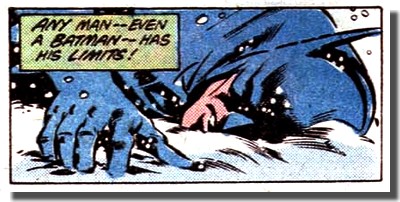 |
|
|
| |
| At yet another location,
Zeus and his men may have managed to shake off the
Batman, but they too now find themselves lost in the
snowstorm and abandon their car as Zeus is certain that
fate will provide them with a haven somewhere. This is precisely the name the
stranger who picked up Batman and has now taken him to
the warmth of his cabin gives to an enquiring Darknight
Detective - "I am simply...Haven".
This mountain of a man calls nature and its animals his
friends as they flock around him, including a sparrow
that mysteriously found Batman. Thankful for the help
received, the Darknight Detective nevertheless remembers
what he came here for and soon ventures out into the cold
and dark again, in spite of protests from Haven.
Out in the wilderness,
however, Batman stumbles across a bear and although he
manages to eventually cause the animal to tumble down a
hillside the vigilante is lost again - and once more,
Haven is there to help him.
|
| |
| However,
upon returning to the cabin, Batman and Haven
discover that Zeus and his gang have since found
the place. Held at gunpoint, the two are told by
Zeus to fight each other gladiator style - to the
death - but Haven announces that he will never
again raise his hand against a fellow man. Provocations, slappings and
beatings cause no reaction in the hermit, but
when Zeus kills the sparrow with his bare hand
even Haven explodes and attacks the gangsters,
who shot him at point blank. Batman makes use of
the ensuing confusion to take out Zeus and his
goons and then sees to the slowly dying Haven who
explains the reasons for his way of life.
|
|
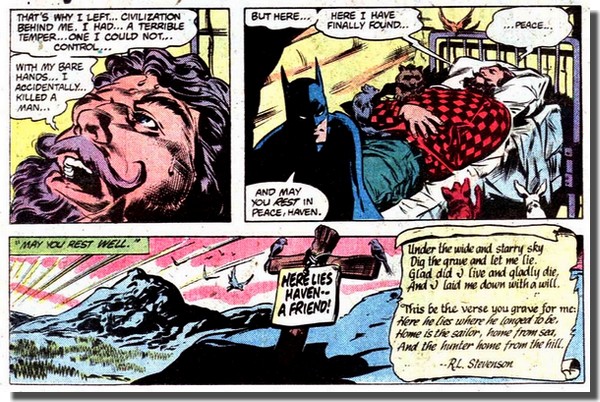 |
|
| |
| Once an irate person who
accidentally killed a man he then chose to leave
civilization behind in order to become a better person
and find - peace. |
| |
REVIEW
& ANALYSIS
After two consecutive
two-issue story arcs crossing over from Batman
into Detective Comics, DC took a
break from this newly introduced crossover format
in order to analyze the first wave of reader as
well as sales feedbacks before deciding on
whether or not to continue with this formula. The
production for the cover date of May 1982 thus
saw two stand-alone stories in both Detective
Comics and Batman, whilst also
giving writer Gerry Conway a break as the writing
of Detective Comics #514 was handed to
Len Wein who, in spite of being only 34, already
was a comic book veteran at the time.
|
|
| |
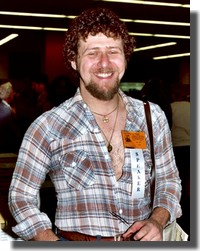
Len
Wein in 1982
(photo
by Alan Light)
|
|
His single
issue story for Detective
Comics #514 - which had no
imminent direct links to the new Batman/Detective
Comics continuity and was
completely self-contained - may
have been a "fill-in"
from a production point of view,
but on a content level Wein
provided readers with a Batman
tale which can be considered
unique in many ways. First of all,
Wein acknowledges inspiration for
his story from outside the world
of comics by explicitly refering
to an album by songwriter Dan
Fogelberg and by quoting from the
poem "Requiem" by
Robert Louis Stevenson - and
readers versed in 1970's TV pop
culture may even wonder if NBC's The
Life and Times of Grizzly Adams
(1977-1979) didn't also add a
touch or two as the visuals of
Haven do bear a certain
resemblance to that show's star
Dan Haggerty.
Secondly,
Wein takes the reader from a
common Batman motive - chasing an
escaped inmate from Arkham Asylum
- very swiftly to completely
unconventional territory in both
the strict sense of the word as
well as in a metaphorical sense.
|
|
|
|
| |
| For
here the Darknight Detective - an urban character through
and through - finds himself desperately struggling
against the forces of nature as his chase leads him out
into the wilderness. This is a territory which is
certainly not his own and which restricts his agility and
his powers so much that in the end he needs to be saved
by someone who is as much at home here as Batman is in
the concrete jungle of Gotham City. |
| |
 |
| |
| On
the level of metaphor, Wein puts forward the question
what we would do when civilization and the societies we
have built turn into monstrosities - would we simply try
to find or even create our own peace and
"haven" somewhere else, such as Haven, or would
we face life the hard way and make a conscious stand
trying to change things ? |
| |
| Wein is far
from blaming those who seek to be at
their own peace - which is what most of
us would no doubt try to do - as long as
this includes trying to be at peace with
the world. At the same time,
Wein underscores the fundamental concept
of the Batman - as long as there are
members of society with bad will and no
scruples, the world needs a Darknight
Detective to protect the peaceful
individuals from going under, which
ultimately serves to help make the world
a better place.
The result is a story
which runs high on moral philosophy and
real life ramifications but still manages
to stay clear from feeding too much of it
to its readers (although the way Haven's
animal friends act in almost human ways
does at times feel very cutesy indeed).
Overall, it is an
interesting and engagingly different take
on the Batman mythos which illustrates
nicely that the underlying elements and
principles of the Darknight Detective's
existence are valid no matter what the
setting and the specific storyline may be
- Batman, quite simply, reflects certain
constants in individuals and society
alike.
Len Wein's
extraordinary plotting for this issue is
complemented by the ever solid artwork to
be expected from Don Newton, whose
pencils provide a dramatic depth and
cinematographic feel to this
interestingly different story and its
blizzard setting, highlighted by great
inks from Frank Chiaramonte and
a fitting mix of colours (and at times
lack thereof) from Adrienne Roy.
|
|
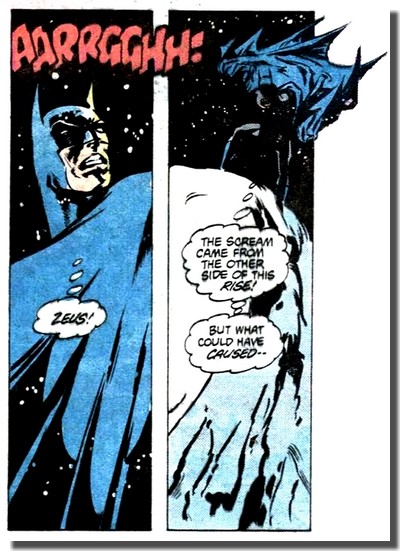 |
|
|
| |
FACTS
& FIGURES
The splash page to
"Haven!" carries the text "WITH THANKS TO DAN FOGELBERG AND "NETHERLANDS" FOR THE INSPIRATION."
Nether Lands
was the fourth album by American
singer-songwriter Dan Fogelberg, released in
1977, with the album's title refering to
Nederland, Colorado, where one of the studios
used to record the album was located
(www.danfogelberg.com). The reference by author
Len Wein most likely refers to the title track of
the album.
|
|
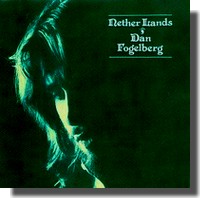 |
|
| |
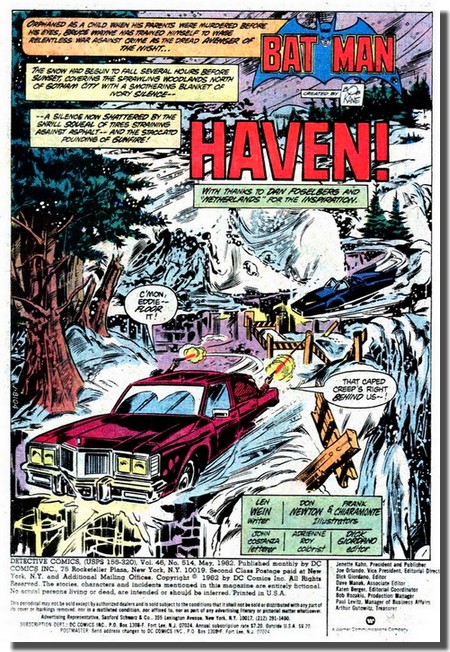 |
|
* * *
High
on this mountain
The clouds down below
I'm feeling so strong and alive
From this rocky perch
I'll continue to search
For the wind and the snow and the sky.
(...)
I've
seen the bottom
And I've been on top
But mostly I've lived in between
And where do you go
When you get to the end of your dream?
Off in the nether lands
I heard a sound
Like the beating of heavenly wings
(...)
Once
in a vision
I came on some woods
And stood at a fork in the road
My choices were clear
Yet I froze with the fear
Of not knowing which way to go
(excerpts
from Netherlands lyrics are © EMI Music
Publishing)
* * *
|
|
| |
TRIVIA
"Haven!"
was reprinted in 1983 in DC's digest Best of DC #35 but
then remained unavailable other than in its original
single issue format up until the publication of Tales of the
Batman: Len Wein
in 2014 which
collects Wein's work on the Caped Crusader and includes Detective
Comics #514.
The
villain featured in this story, Maxie Zeus, first appeared in
Detective Comics #483 (April/May 1979) in "The
Curse of Crime Alley".
"Haven!" also saw
publication in a number of foreign language versions, the
first being fairly soon after its original publication,
i.e. in November 1982, when it featured in the Norwegian Gigant
#9.
|
| |
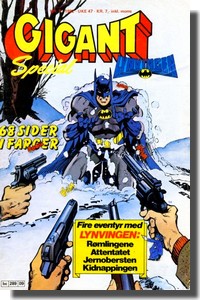 |
|
Published by
Semic AS (Nordisk Forlag), Gigant
was a monthly 68-pages title
which featured DC material
translated and compiled for the
Norwegian market. Gigant
was published from April 1977
until March 1985 to a total of 62
issues, each featuring
one DC character - and apart from
Batman, its Norwegian readers
could also enjoy e.g. Sumpvesenet
(Swamp Thing) or Mirakelkvinnen
(Wonder Woman). Semic AS
published a wide range of comic
books, many of which featured
adapted and translated material
originally taken from US
publications. Batman starred in Lynvingen
from February 1997 up until
August 1981, with some of the 52
issues printed in Hungary (which,
of course, was still behind the
Iron Curtain at the time). He
then appearaed again in Batman
from January 1989 to October 1991
and then again from January 1994
to June 1995 (with the latter run
featuring material from Batman
Adventures). Other superhero
titles from Semic included
Marvel Spesial (1987-1989)
and DC Presenterer
(1988-1989).
|
|
|
|
| |
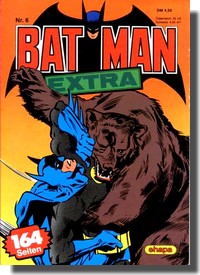 |
|
Between
1977 and 1978 Semic was also known as Williams
Forlag AS, a reference to its partner company
Williams which in turn belonged to Warner
Brothers - and which strangely enough did not
have the publishing rights to Batman nor Superman
for the German language markets of Germany,
Switzerland and Austria at the time.
"Haven!" was thus published by the
German publishing house Ehapa (who had the
exclusive distribution rights for DC from 1966 up
until 1989, with the exception of Green Lantern
and Horror) in Batman Extra #6
in 1982, shortened by one page (which was a
common practice at Ehapa at the time in order to
fit more advertising space into their comics).
The cover emphasizes Batman's struggle with the
bear and is taken from an interior page panel of Detective
Comics #514. |
|
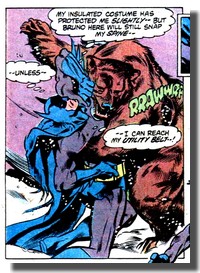 |
|
| |
| "Haven" was also
reworked in 1984 for the Dutch market as second story of Batman
#6 by Baldakijn publications [1],
and the exact same content - Batman #347
together with Detective Comics #514 - was
published in February 1984 for the Spanish market in Batman
vol. 1 #2 by publisher Zinco [2]. Detective Comics #514
carries both a full page interior cover advertisement for
the Avco Embassy movie Swamp Thing as well as a
half-page in-house advert for DC's Saga of the Swamp
Thing #1 with another plug for the movie ("NOW A MAJOR MOTION
PICTURE FROM AVCO-EMBASSY!"). Hindsight of course tells us that
the 1980's were not the right time for comic book movies
- Swamp Thing failed miserably at the box office
and got a beating from critics, just as Marvel's Howard
the Duck would in 1986.
|
| |
COMMENTS FROM THE BATCAVE
from
the letters page of Detective Comics #519
|
| |
 |
|
"'Haven' has the
atmosphere, the poignance, and the charm that
make me wish every comic was like this. Why
doesn't Len Wein write more often?" (Mark
Lagasse, Hoosick Falls NY)
"It
is these occasional meetings with people like
Haven (...) that make The Batman realize (as if
he ever held any doubts) why he exists."
(Aaron Mathisen, Chico CA)
"This
was a fine story, Len (...) please come back real
soon!" (Kent A. Phenis, Indianapolis IN)
|
|
|
BATMAN and all
related elements are the property of DC
Comics, Inc. TM and © DC Comics, Inc.,
a subsidiary of Time Warner Inc.
The illustrations presented here are
copyright material. Their reproduction for
the review and research purposes of this
website is considered fair use as set out by
the Copyright Act of 1976, 17
U.S.C. par. 107.
|
| |

(c)
MMXII-MMXV
first posted
1 May 2012
revised,
expanded and reposted 15 March
2015

|
| |
|
